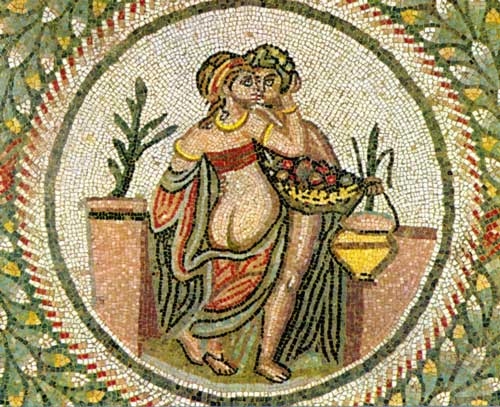Home - In and around
LUXURY ROMAN VILLA IN PIAZZA ARMERINA
Villa del Casale in Piazza Armerina is the supreme example of a luxury Roman villa, which graphically illustrates the predominant social and economic structure of its age. The mosaics that decorate it are exceptional for their artistic quality and originality, as well as their extension.
The grandeur and lavishness of the structure built on the ruins of the house suggests that it was built on order, if not of a Roman ruler, if not a rich and powerful landowner, between 310 and 340. It was inhabited until the invasion Arab of the 9th century, although in a state of increasing degradation. The final act of destruction is operated by the Norman king of Sicily, William the Bad, around 1155.
The villa is built on a series of terraces. The first is the monumental entrance, which opens into a courtyard, which overlooks the elaborate complex of baths. Oval gym provides access to an impressive octagonal frigidarium (cold room) and then through the tepidarium (warm room), from which there are three calidaria (hot baths). It follows the impressive main peristyle with its monumental fountain in the center, and the rooms that open out of it. There is a small sanctuary apse on one side. To the south is the third group, around the peristyle elliptical. The large triclinium has apses on three sides and is decorated with mythological scenes, particularly the Labours of Hercules. The fourth group is located east of the main peristyle, connected by a long corridor with the scene of the Great Hunt. This monumental area contains one of the most beautiful mosaic floors and most deservedly famous, depicting the capture of wild animals in Africa, with the master and his assistants who direct the activities of the center. This group also includes the basilica, a large function room, which is paved in marble mosaics instead. Most small private rooms in this part of the complex accommodate floor mosaics depicting more peaceful and domestic activities. Particularly well known is the group of young women wearing very similar costumes to modern bikinis, engaged in sports activities. The mosaics are the glory of the Villa del Casale. Date back to more advanced period of art of the mosaic and were probably the work of artists from North Africa, to judge both the quality of work and the scenes depicting. For stylistic reasons it is believed that at least two mosaic masters who worked on the house, one with a more classic style for the mythological scenes and the other using a more realistic approach to the scenes of contemporary life.
unescosicilia
The grandeur and lavishness of the structure built on the ruins of the house suggests that it was built on order, if not of a Roman ruler, if not a rich and powerful landowner, between 310 and 340. It was inhabited until the invasion Arab of the 9th century, although in a state of increasing degradation. The final act of destruction is operated by the Norman king of Sicily, William the Bad, around 1155.
The villa is built on a series of terraces. The first is the monumental entrance, which opens into a courtyard, which overlooks the elaborate complex of baths. Oval gym provides access to an impressive octagonal frigidarium (cold room) and then through the tepidarium (warm room), from which there are three calidaria (hot baths). It follows the impressive main peristyle with its monumental fountain in the center, and the rooms that open out of it. There is a small sanctuary apse on one side. To the south is the third group, around the peristyle elliptical. The large triclinium has apses on three sides and is decorated with mythological scenes, particularly the Labours of Hercules. The fourth group is located east of the main peristyle, connected by a long corridor with the scene of the Great Hunt. This monumental area contains one of the most beautiful mosaic floors and most deservedly famous, depicting the capture of wild animals in Africa, with the master and his assistants who direct the activities of the center. This group also includes the basilica, a large function room, which is paved in marble mosaics instead. Most small private rooms in this part of the complex accommodate floor mosaics depicting more peaceful and domestic activities. Particularly well known is the group of young women wearing very similar costumes to modern bikinis, engaged in sports activities. The mosaics are the glory of the Villa del Casale. Date back to more advanced period of art of the mosaic and were probably the work of artists from North Africa, to judge both the quality of work and the scenes depicting. For stylistic reasons it is believed that at least two mosaic masters who worked on the house, one with a more classic style for the mythological scenes and the other using a more realistic approach to the scenes of contemporary life.
unescosicilia



